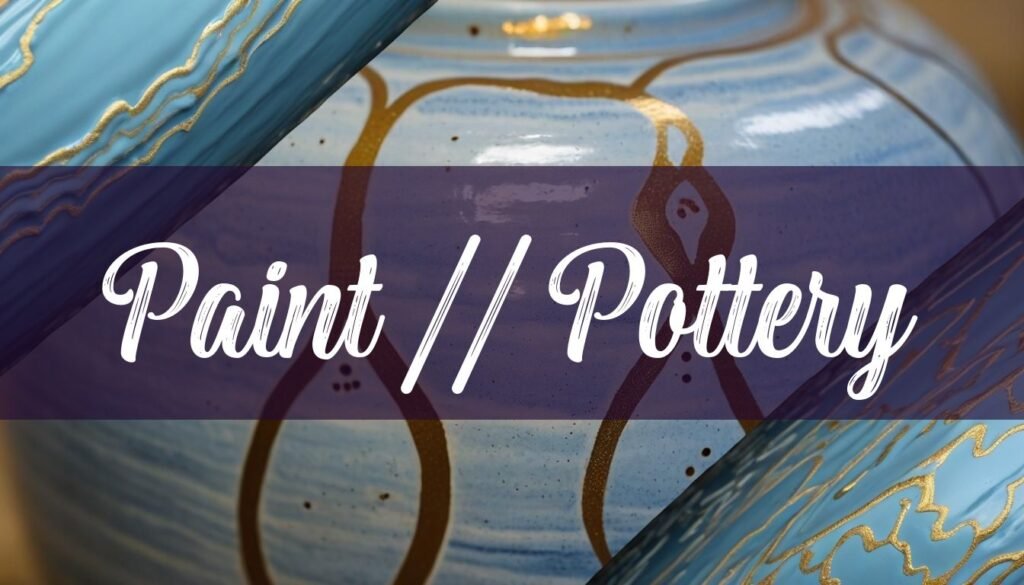Painting pottery opens up a world of creative possibilities, allowing you to personalize and embellish ceramic pieces with color and design. However, the type of paint you choose is crucial, as it affects the durability, finish, and functionality of your pottery. This article explores the diverse range of paints suitable for pottery, providing guidance on selecting the right materials for your specific projects. You may even find that you want to buy a ceramic to paint!
Understanding Different Types of Pottery Paints
When considering what paint to use for pottery, it’s essential to distinguish between options designed for pre-firing application and those intended for use after the piece has been fired. Traditional methods involve using ceramic materials like underglazes, slips, and oxide stains, which fuse with the clay body during firing. These become integral to the ceramic, ensuring longevity and resistance to wear. Underglazes, for example, can be applied thinly to mimic watercolor effects or more thickly for bolder, acrylic-like results. Slips, which are liquefied clay suspensions, can be white or tinted with oxides to add color. Oxide stains are excellent for creating flowing lines and broad color areas and are often commercially prepared with fritted material for safety and stability. Ceramic glazes are specifically formulated to bond with the ceramic surface and withstand high firing temperatures, permanently setting the colors.
However, for decorative pieces that won’t be used functionally, you can explore other options. Acrylic paints are a popular choice for painting bisque ceramics due to their versatility, quick drying time, and ease of use. These water-based paints adhere well to the porous surface of ceramics, creating a durable finish. Enamel paints, available in both oil-based and water-based forms, can also be used to create a glossy, protective layer, making them suitable for functional items like mugs or plates, though food safety should always be a priority. Glass paints offer a translucent finish for a stained-glass effect, but they require heat-setting, which may not be appropriate for all ceramic pieces. It’s crucial to remember that while acrylic paint can be used on fired pieces, this is considered a “cold finish” and does not make the piece food-safe. To achieve a durable, food-safe finish, glazing is essential.
Surface Preparation and Application Techniques
Proper surface preparation is key to ensuring optimal paint adhesion and a smooth, durable finish. Before painting, the ceramic surface must be clean, dry, and free of any dust or contaminants. Wiping the bisque pottery with a damp sponge or cloth is a simple yet effective way to remove dust. For previously glazed surfaces, light sanding can help create a better surface for the paint to adhere to. After sanding, remove any dust with a clean cloth. Priming the ceramic before painting is also highly recommended, as primers help the paint adhere better and last longer. For air-hardening clay, ensure it is completely dry and sealed with a clay varnish or acrylic gloss medium to prevent the porous clay from absorbing moisture from the ceramic paints.
Various application methods can be employed to achieve different effects. Glaze painting involves applying a glaze to the ceramic piece, followed by firing in a kiln. Slip trailing uses a thin, watery clay mixture, applied with a small nozzle or syringe to create raised designs. Sgraffito involves scratching the surface of the ceramic piece to create a design, using a sharp tool to scrape away the top layer. Stenciling involves using a stencil to create a design, while decals and transfers use pre-made designs applied with water or heat. Airbrushing uses a special tool to apply paint or glaze, creating effects like gradients or shading. Other techniques include masking with tape to block off designs, bubble blowing to create unique patterns, and using sponges or stamps to add texture and detail. Brushing can be used as both a base layer and for decorating, with different brush sizes suited for various effects. Dipping is the easiest way to cover pottery, providing a smooth look and fine texture. If you’re wondering how to glaze pottery for beginners, start with simpler designs and techniques.
Firing Temperatures and Sealing for Food Safety
The firing temperature significantly impacts the outcome of the painted pottery. All clays and glazes are designed to mature at specific temperatures, and any deviation can lead to unsatisfactory results in ceramic durability or color. Low-fire pottery is fired at the lowest temperatures, ranging from 1,700°F to 2,100°F (Cone 04-06), while mid-range pottery is fired at intermediate temperatures, typically between 2,100°F and 2,300°F (Cone 5-6). High-fire pottery ranges from 2,300°F to 2,700°F (Cone 9-10). Earthenware clay performs well when fired at low temperatures, while stoneware clay bodies are intended for mid-range temperatures. High-fire stoneware clay bodies are created to endure high firing temperatures, resulting in a dense and non-porous final product.
To make painted pottery food-safe and waterproof, proper sealing is essential. Acrylic paint, while durable, is not inherently waterproof or food-safe when applied to ceramic surfaces. Sealing protects the paint from chipping and fading and can make the ceramic suitable for practical use. Options for sealants include ceramic glaze for a glossy finish and added durability, dishwasher-safe Mod Podge if the item will be washed in a dishwasher, and acrylic sealer spray for a quick and easy sealing process. Apply the sealant in a well-ventilated area, using even strokes to cover the entire painted area, and follow the manufacturer’s instructions for drying times. For mugs with vinyl designs, use a food-safe sealant that is FDA-approved and non-toxic. Apply three thin coats, allowing drying time between each coat, and cure the mug either by baking it in the oven or letting it sit for 28 days. Always ensure that sealants are specifically designed for surfaces that come into contact with food and drinks.





